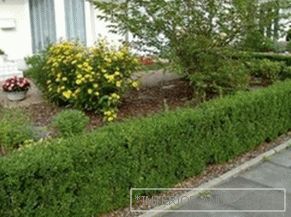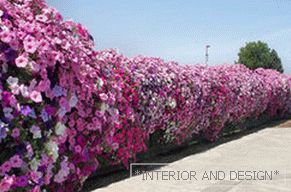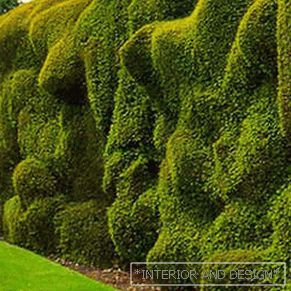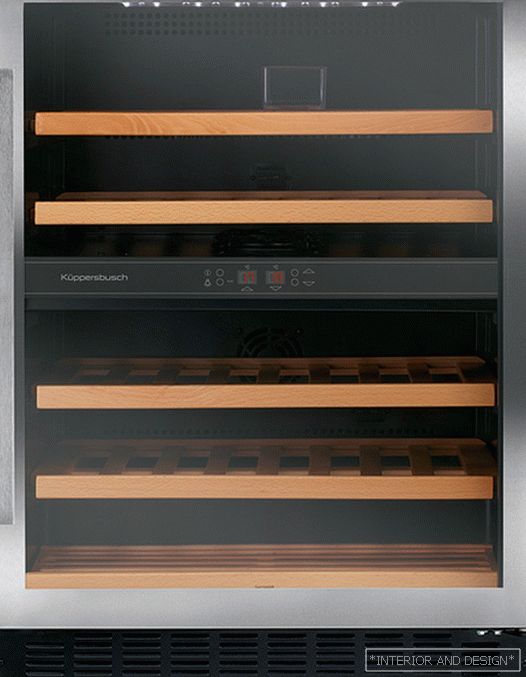 Hedge является отличной альтернативой глухим заборам и ограждениям из камня, кирпича, металла, ведь она экологична, привлекательна и естественна. Кроме этого, живая изгородь отлично сочетается с различными элементами ландшафтного дизайна на даче: клумбами, альпийскими горками, водоемами.
Hedge является отличной альтернативой глухим заборам и ограждениям из камня, кирпича, металла, ведь она экологична, привлекательна и естественна. Кроме этого, живая изгородь отлично сочетается с различными элементами ландшафтного дизайна на даче: клумбами, альпийскими горками, водоемами.
Content
- 1 Hedge - what is it?
- 2 Advantages and disadvantages of hedge
- 3 Types and varieties of plants for hedge
- 4 Planting plants for hedge
- 5 Hedge care
- 6 Emerging hedge problems
Hedge - what is it?
As the name implies, the hedge is a kind a fence of green space: trees, shrubs or grassy plants that are planted tightly in one or more rows. From trees and shrubs you can form various shapes, cutting out leaves according to a certain plan. It looks great fence from climbers and flowers, and trellis lanes are a good support for the branches. Hedges, except for decorative purposes, are quite household functions: protection from any penetration, whether it be people or animals, from prying eyes and others.
Advantages and disadvantages of hedge
The fence of living plants pleases the views of the lush greenery of the villa owners and passers-by; in addition, it carries a protective function against wind, noise and dust. Also, the fence actively produces oxygen, creates cozy microclimate and comfortable conditions for recreation at their summer cottage. You will spend much less effort and money on building a hedge than on building a good and solid fence.
Also to the advantages of a hedge include:
- The fact that she does not need to paint, the maximum that she needs is a haircut and dressing.
- It masks everything you need to hide, it can be unsuccessful buildings.
etc. - The hedge lures into the garden beneficial insects that pollinate plants and flowers.
- Provides some species of birds with housing, winding their nests in trees and shrubs.
The negative side of a hedge is that its creation requires a lot of timeabout 5 years. Although with the availability of funds, you can buy and plant already adult plants, but if the budget is small, you will have to wait a while for the plants to grow.
Often, some are used as a living fence. shrubs or fruit trees. Such a fence gives a good harvest, but you need to remember and be prepared for the fact that the type of pavement walkway or lawn can be spoiled by showered berries or fruits.
Types and varieties of plants for hedge
 A hedge of plants will look beautiful in the country, will benefit and a lot of positive moments if you choose the right plants for it. Alive hedges may be low (curb, height up to 50 cm), medium height (height from 0.5 m to 2 m) and high (otherwise they are called - living walls, a height of 2 m and above). For each type of fence there is a certain selection of plants.
A hedge of plants will look beautiful in the country, will benefit and a lot of positive moments if you choose the right plants for it. Alive hedges may be low (curb, height up to 50 cm), medium height (height from 0.5 m to 2 m) and high (otherwise they are called - living walls, a height of 2 m and above). For each type of fence there is a certain selection of plants.
A hedge can be prickly, blooming and even edible. It is clear that it can be edible only when its location is not near a busy highway, otherwise the fruits accumulate harmful substances and are not suitable for consumption.
The best option for hedges are coniferous trees, because they saturate the air with beneficial essential oils, but their disadvantage is that they grow rather slowly. For high hedges are used: white turf, blood red, green thuja, common spruce, cotoneaster, privet, plum, cherry, alder, as well as:
- Barbary Tunberg;
- Juniper;
- Black cotoneaster;
- Snowberry;
- Chokeberry;
- Elderberry;
- Acacia yellow;
- Hawthorn;
- Shrub willow;
- Sea buckthorn;
- Rosehip and others.
A hedge can consist of deciduous and evergreens. It is not always the composition of the hedge should be uniform. Often, such a fence is made from different species and varieties.
In addition to all of the above, hedges can be divided into:
- External изгороди, которые служат границей участка или же огораживают какую-нибудь его часть. Для таких изгородей используются высокие деревья и shrubs.
- Internal, which are a kind of dacha separators into functional zones. They are used for fencing flower gardens, lawns, paths. For the internal fences will be appropriate: lavender, honeysuckle shiny, pussy, ivy, some types of roses, boxwood, yew.
Planting plants for hedge
 Before starting the arrangement of a hedge it is necessary to mark its shape on the ground. Be sure to retreat from the existing fence or structure at least half a meter. When selecting plants for hedge it is desirable to give preference young seedlings. The optimum age for deciduous plants is several years, and for conifers the age varies from 4 to 5 years. At this age, they are easier to take root and adapt to the new environment.
Before starting the arrangement of a hedge it is necessary to mark its shape on the ground. Be sure to retreat from the existing fence or structure at least half a meter. When selecting plants for hedge it is desirable to give preference young seedlings. The optimum age for deciduous plants is several years, and for conifers the age varies from 4 to 5 years. At this age, they are easier to take root and adapt to the new environment.
The best time to plant a hedge is the middle of spring. Planting should be carried out not in the hole, but in a specially dug trench. The distance between the planted seedlings should not exceed 40−60 cm from each other.
Gaps for unshaped hedges can reach up to 1.5 m from each other. Large shrubs are planted in one row, and small in 2 rows, preferably in a checkerboard pattern.
Before landing in the trench is necessary make organic and mineral fertilizers. The roots of deciduous plants must be held for several hours in water, and then treated with a solution of clay and humus.
It is recommended to plant seedlings not by eye, but along an outstretched cord or rope. After planting, the soil must be compacted and watered 2-3 times.
Hedge care
 For the hedge to be useful and to delight the eye, care is needed for it. It should be cut regularly (this applies to the molded hedge), watered, weeded and periodically fed.
For the hedge to be useful and to delight the eye, care is needed for it. It should be cut regularly (this applies to the molded hedge), watered, weeded and periodically fed.
In the first two years, the young hedge must be cut often enough: for crown formation and the overall appearance of the hedge. This should be done so that the base of the fence is wider than the top. This makes it possible to obtain sunlight and lower branches of the hedge. Then the hedge trim can be reduced to 2 times a year (in early spring, before flowering and at the end of June). If a hedge is trimmed once a year, then it should be done in August. Separate thin branches can not be cut off, but braided with others, thereby compacting the living wall.
During the haircut, dried and frozen branches are removed so that they do not clog the fence and do not become carriers of various pests. For better rejuvenation of shrubs, they are pruned very strongly to perennial bitches. And to give the crown width and thickness, it is necessary to cut off young shoots.
For some plants no pruning: it is maple, quince, evergreen barberry and some others.
Watering plants depends on the individual characteristics of each plant and the composition of the soil. For example, clay or loamy soils are often not recommended for watering, as they can be swamped, but they cannot be overdried. Watering must be done in the morning or evening.
Emerging hedge problems
 Hedge Problems:
Hedge Problems:
- With the defeat of plants from hedge fungus, it is necessary to trim all the branches that have grown during the year.
- If plants die due to lack of sunlight, it is necessary to give a hedge another shapepreferably trapezoidal.
- If all the plants are sick, then they can be cut at the root. In this case, the fence will lose some of its attractiveness, but the plants will recover faster. It will take less time than planting and growing a new hedge.
- In addition to pruning, the plant can be cured. special preparations: from fungus or from pests.
- For faster recovery, a hedge is needed water and fertilize.
- Cut off the affected areas of the fence should be immediately burned so that the disease does not spread further to other plants.
Being engaged in the creation of a hedge in his country house with his own hands, any summer resident acts as a creator. After all, he himself creates unique masterpieces, which is the living fence. But to listen to some recommendations is necessary for them. If the cottage is only a place for summer holidays, then it is advisable to concentrate attention when creating a hedge on flowering plants. And if the cottage is visited in the winter, the presence of evergreens is also necessary.



